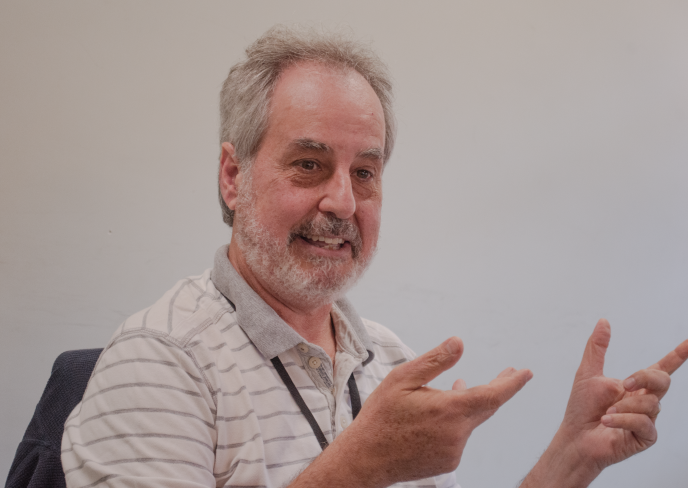
Professor Fabrício Rodrigues dos Santos, from the Institute of Biological Sciences at UFMG
Photo: Yan Marques – IEAT/UFMG
Professor Fabrício Rodrigues dos Santos, from the Institute of Biological Sciences at UFMG, presented his research project at the fifth meeting of the IEAT Residents’ Exhibition, held on June 4, 2025, at UFMG’s Administrative Unit 3.
In the presence of fellow IEAT residents, Fabrício Santos spoke about the research Science of Brazilian natural and cultural heritage. Initially, he presented a comprehensive overview of studies in the area of Genetics and Human Evolution, highlighting the importance of interdisciplinary collaboration between genetics and areas such as anthropology, history, archaeology and linguistics, among others.
According to the professor, this integration of knowledge is essential both for understanding human history from its earliest records and for preserving the material traces of this history. He highlighted, for example, the importance of conserving Brazil’s cultural and natural heritage. “Brazil has the greatest biodiversity on the planet, which corresponds to a genetic heritage of enormous strategic value. However, this heritage is not valued, to a large extent, because it is not known and no importance is given to its conservation, either in natural environments or in scientific collections. For example, we visited some collections where small fossil samples were stored in matchboxes,” highlighted Fabrício Santos.
Therefore, according to him, in-depth study and knowledge are necessary above all. “It is essential to know and study the heritage in order to then develop preservation mechanisms and, subsequently, make sustainable use of it. It is also necessary to invest in the creation and maintenance of collections, archives and museums that preserve our heritage, as a way of ensuring its conservation. These are fundamental initiatives,” he emphasized.
To demonstrate how knowledge about anthropological heritage is produced, Fabrício Santos presented data on the natural history of the human species, which has been possible to understand thanks to multidisciplinary scientific integration. According to him, the spread of the human species across the globe began more than 200,000 years ago, with humans originating on the African continent, and from 70,000 years ago they began to expand to Europe, Asia and, later, to the Americas, around 20,000 years ago.
The arrival in South America, 14,000 years ago, marked the emergence of the first populations on our continent. Until the beginning of the great navigations, around 1500, gene flow between continental populations was limited. However, studies in human genealogy demonstrate the significant increase in the miscegenation of peoples from various continents in South America and, in particular, in Brazil. For example, the study Genetic Admixture in Brazil, published in 2020 by Fabrício Santos and colleagues from ICB/UFMG, points out that the average probability of a typical Brazilian having triple indigenous American, African and European ancestry is 99.9998%. “These data indicate that the Brazilian population is tri-hybrid,” highlighted Fabrício Santos.
Continuing the presentation, he discussed research conducted in dialogue with indigenous communities in Brazil and the United States, including skeletal remains from archaeological sites. One of the studies presented, supervised by Fabrício, is the result of Thomaz Pinotti’s doctorate, carried out in a joint supervision between UFMG and the University of Copenhagen, in Denmark. The research analyzed ancient DNA from Chaco Canyon (an archaeological park between New Mexico and Arizona) and was published in April 2025, in the journal Nature. The study contributed to the United States government’s recognition of the ancestral connection between the indigenous people of Picuris Pueblo and those ancient indigenous people who inhabited the archaeological site.
After presenting the contributions of genetics in conjunction with other areas, Fabrício spoke about the work being developed within the scope of the National Institute of Science and Technology based at UFMG, IN2PAST.BR, an initiative that is part of his residency at IEAT. The project, implemented in 2024, operates on several fronts, addressing the following research axes: Anthropological and archaeological heritage (Human History); Natural heritage (biodiversity, genetic and paleontological heritage); Advanced and transversal technologies applied to museum objects and collections (Tangible and Intangible Heritage); and Scientific information management, with a focus on the interoperability of scientific data.
According to the professor, the project will promote interdisciplinary collaboration between researchers in areas such as genetics, linguistics, archaeology, anthropology, among others. One of the focuses of the research is the Center for Taxonomic Collections (CCT-UFMG) at UFMG, linked to the Institute of Biological Sciences. Fabrício highlighted that taxonomic collections are relevant both as research objects and for teaching the history of science in Brazil. “The CCT/UFMG is the largest repository of Brazilian biodiversity in the state of Minas Gerais, with 26 different collections that help preserve the memory of national biodiversity,” he said.
Next, Fabrício Santos highlighted the value of collections and scientific curation. As an example, he mentioned owl acorns in caves, which are samples of food regurgitated by these birds and which contain indigestible parts of rodents, such as fur, bones and shells. These acorns were deposited by owls over several millennia, such as in the caves of Peruaçu National Park, where a subproject of IN2PAST.BR coordinated by professors Fernando Perini, from ICB, and Jacqueline Rodet, from the Department of Anthropology and Archaeology, of the School of Philosophy and Human Sciences (Fafich) of UFMG, aims to evaluate the role of ancient climate changes in the diversity of rodents in the region, over the last 20 thousand years.
Finally, Fabrício Santos demonstrated advanced scientific applications of research into national cultural and artistic heritage within IN2PAST.BR. For example, in X-ray image analysis, spectral imaging and other revolutionary methods of object research that can be applied, for example, in the authentication and forensic investigations of works of art.